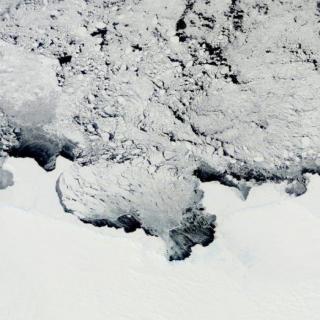
介绍:
An ice shelf about the size of New York City has completely collapsed in East Antarctica within days of record high temperatures, according to satellite data.
The Conger ice shelf, which had an approximate surface area of 1,200 sq km, collapsed around 15 March, scientists said on Friday.
East Antarctica saw unusually high temperatures last week, with Concordia station hitting a record temperature of -11.8C on 18 March, more than 40C warmer than seasonal norms. The record temperatures were the result of an atmospheric river that trapped heat over the continent.
Ice shelves are extensions of ice sheets that float over the ocean, playing an important role in restraining inland ice. Without them, inland ice flows faster into the ocean, resulting in sea level rise.
Dr Catherine Colello Walker, an earth and planetary scientist at Nasa and the Woods Hole Oceanographic Institution, said though the Conger ice shelf was relatively small, “it is one of the most significant collapse events anywhere in Antarctica since the early 2000s when the Larsen B ice shelf disintegrated”.
“It won’t have huge effects, most likely, but it’s a sign of what might be coming,” Walker said.
The Conger ice shelf had been shrinking since the mid-2000s, but only gradually until the beginning of 2020, Walker said. By 4 March this year, the ice shelf appeared to have lost more than half its surface area compared to January measurements of around 1,200 sq km.
Peter Neff, a glaciologist and assistant research professor at the University of Minnesota, said that to see even a small ice shelf collapse in East Antarctica was a surprise.
“We still treat East Antarctica like this massive, high, dry, cold and immovable ice cube,” he said. “Current understanding largely suggests you can’t get the same rapid rates of ice loss [as in West Antarctica] due to the geometry of the ice and bedrock there.”
“This collapse, especially if tied to the extreme heat brought by the mid-March atmospheric river event, will drive additional research into these processes in the region.”
Satellite data from the Copernicus Sentinel-1 mission showed that movement of the ice shelf began between 5 and 7 March, Neff said.
Helen Amanda Fricker, a professor of glaciology at the Scripps Polar Center, said that three calving events – when ice chunks break off from the edge of a glacier – had occurred in East Antarctica in March. In addition to the Conger ice shelf collapse, there were smaller calving events of the Totten glacier and Glenzer ice shelf.
“Much of East Antarctica is restrained by buttressing ice shelves, so we need to keep an eye on all the ice shelves there,” Fricker said in a tweet.
Prof Andrew Mackintosh, head of the school of earth, atmosphere and environment at Monash University, said the Conger ice shelf had significant amounts of melting from the ocean beneath, which could have preconditioned it for collapse.
“Ice shelves lose mass as part of their natural behaviour – but the large-scale collapse of an ice shelf is a very unusual event,” Mackintosh said. “This seems to be a collapse rather than normal behaviour.
“The collapse itself, however, may have been driven by surface melting as a result of the extremely warm temperatures recently recorded in this region. More evidence is needed to link this collapse to the recent warming.”
Surface melt was responsible for the Larsen B ice shelf collapse in 2002.
The Antarctic heat event began on 15 March, said Alex Sen Gupta, an associate professor at the University of New South Wales. “It looks like large parts of eastern Antarctica reached over 20C warmer than normal,” he said.
Prof Matt King, who leads the Australian Centre for Excellence in Antarctic Science, said because ice shelves are already floating, the Conger ice shelf’s break-up would not in itself impact sea level much. He said that fortunately the glacier behind the Conger ice shelf was small, so it would have a “tiny impact on sea level in the future”.
大家还在听

